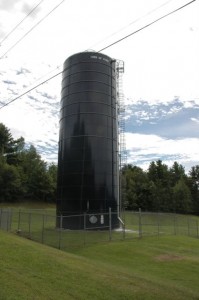Town of Peru continues its efforts to bring water quality up to standard
By John T. Ryan
About 100 Peru households have been subject to a boil water order since Tuesday, August 17th. Peru Water and Sewer Superintendent Greg Timmons is hopeful that that the order will be lifted sometime today. On Tuesday Peru’s Water Department staff drained and cleaned the Reservoir Rd. water tower necessitating the boil water order. The cleaning is part of an ongoing effort to reduce the town’s drinking water haloacetic acid levels and bring the town into compliance with EPA water quality standards. Peru Town Supervisor Peter Glusho says that significant progress has been made and that one of the acid levels has been brought into compliance. He said, “We’re looking for the most cost effective and the most permanent way to solve the problem.” Town residents have been receiving periodic “Violation Notices” for the past three or four years. Greg Timmons says he sometimes gets about ten to fifteen phone calls from concerned residents when notices are issued. This is not surprising given the fact that the notice reads, “Some studies of people who drank chlorinated drinking water for 20-30 years show that long term exposure to disinfection by-products (possibly including haloacetic acids) is associated with an increased risk for certain types of cancer.”
Clinton County Health Department Environmental Health Director John Kanoza says Peru’s problem results from the community being dependent on surface water as a drinking water source. Peru’s reservoir fed by springs and streams contains organic materials such as leaves, algae, and bird and animal residues, hence water disinfection requires higher chlorination levels than water derived from a ground water source, i.e. wells. Unfortunately, when chlorine is combined with certain acids that are naturally occurring in organic matter such as leaves, algae, etc., haloacetic acids are formed. Temperatures, the amount of organic materials and variety of other factors can also influence halacetic acid levels. The fact that Peru hamlet water has to be piped to the tower adjacent to the town garage plays a role in Peru’s problem. If the water could be chlorinated at the hamlet tower the haloacetic acid levels would probably be reduced. Rouses Point was able to reduce its levels by chlorinating at its tower. Peru’s tower and water system design do not lend themselves to this solution.
John Kanoza said Peru is not the only Clinton County community that receives violation notices, however Peru’s have been reoccurring. He said he is working closely with Greg Timmons and that Peru has made substantial progress. He has recommended that the town flush fire hydrants up to four times annually. Another step could be the use of different chemicals at the treatment plant. If Peru doesn’t bring its water into compliance at some point the state could require a very expensive remedy such as drilling wells.
Greg Timmons said the town made significant progress when it replaced the treatment plant’s activated carbon filters two years ago and that the town is very, very close to meeting EPA requirements. He said, “We’re trying to hold down the costs to taxpayers. We’re working with the Health Department and trying to do it in-house.” Timmons pointed out that up until four years ago the town met EPA standards; however, the EPA lowered the acceptable levels of haloacetic acids by about 20%. He plans to flush the hydrants more frequently and to follow Health Department recommendations. He mentioned using different chemicals at the treatment plant or the possibility of installing ultraviolet filters to replace chlorine. The ultraviolet filters could cost taxpayers from $150,000 to $200,000. No action is guaranteed to fix the problem and that ‘s why he is using an incremental approach to arrive at a solution.
Posted: August 19th, 2010 under Peru/Regional History, Town Board News.

